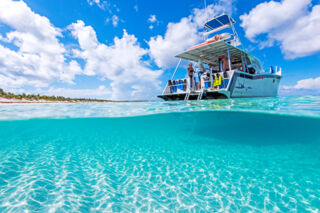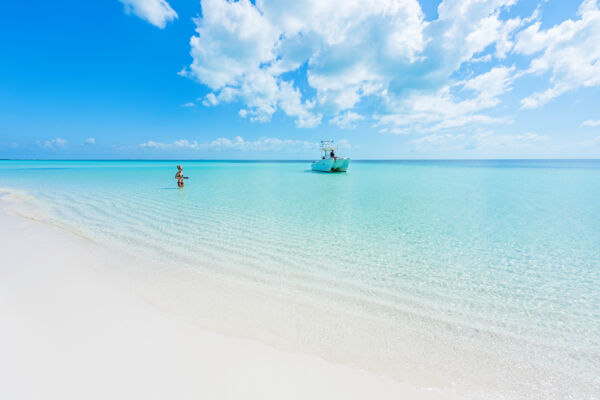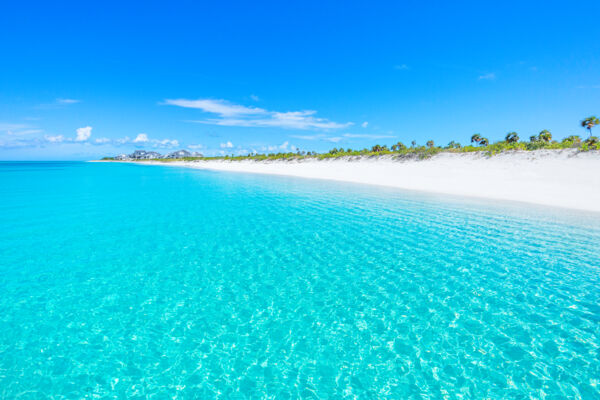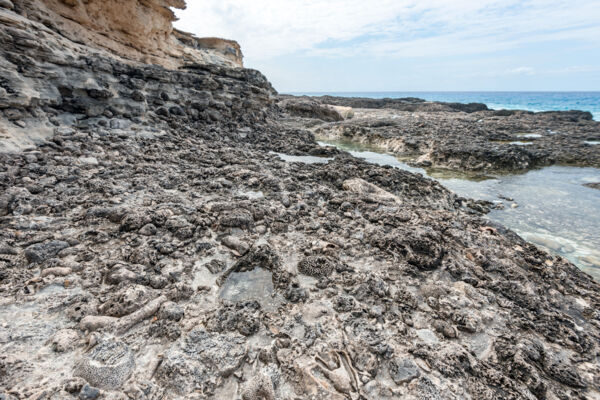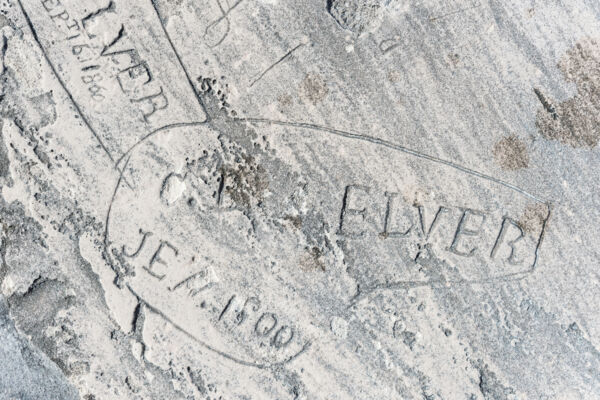Discover West Caicos
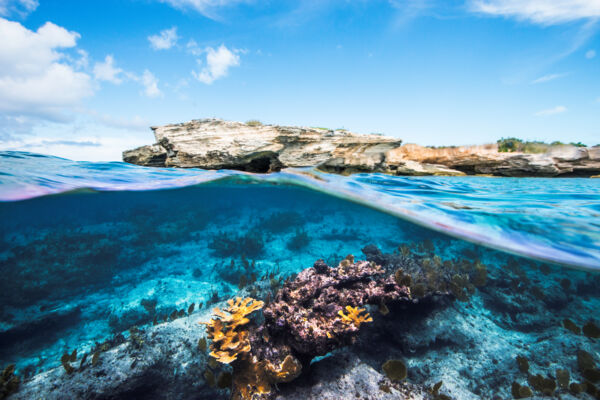
West Caicos, formerly known as Belle Island, is the last island in the Turks and Caicos archipelago to the west, and the second largest uninhabited island in the country. The island has a collective area of about 11 square miles (28.5 km²) with generally flat terrain. The expansive West Caicos Marine National Park protects a large portion of the waters around the island.
The west coast of the island offers miles of beautiful low ironshore cliffs, and the other sides make up about 5 miles (8 km) of pristine beach. West Caicos currently has ruins from several centuries, along with the unfinished buildings of the Molasses Reef Resort project.
With incredible scuba diving offshore, the island is a popular destination for Providenciales scuba diving companies and liveaboards.
Boat Charters and Attractions
West Caicos is a spectacular place to visit on a charter excursion from Providenciales, as it combines a little of everything.
Beautiful snorkeling surrounds the island, and is especially fascinating on the coast of the West Caicos Marine National Park. The cliff coastline here hides many fun little caves, and there is some great cliff jumping sites as well. The Yankee Town historical site is a short walk from the coasts, as is Lake Catherine.
Shared public charters typically do not visit West Caicos, due to its greater distance from Providenciales compared to likewise exquisite locations such as Half Moon Bay and Fort George Cay, so it’ll probably be necessary to arrange a private charter if you’d like to visit West Caicos on a day trip.
Diving
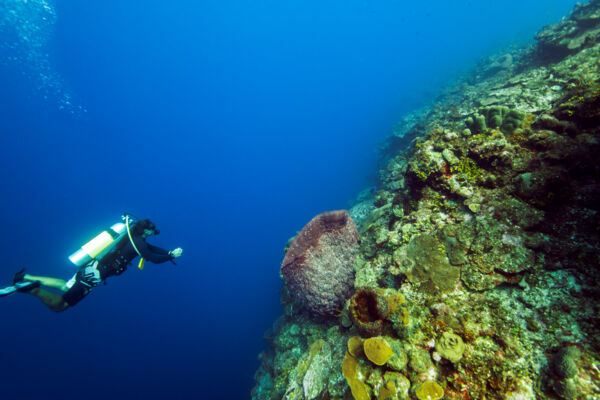
Today, West Caicos is best known for the excellent diving surrounding the island. Off the west side of the island is some of the best wall diving in the country, with sheer drops from about 40 feet (12 m) down to 6,000 (1,800 m). The northern and eastern sides also offer excellent relatively shallow sites with plenty of sponges and rays.
Some of the amazing dive sites in the West Caicos Marine National Park include Gullies, Rock Garden, Yankee Town, Highway to Heaven, Elephant Ear Canyons, Driveway, and Spanish Anchor.
As West Caicos is uninhabited, dive trips to the island depart from Providenciales. Typically, two-tank dives from central Providenciales have a trip duration of 5–6 hours, including travel, dives, and surface intervals. Liveaboard yachts offer overnight diving trips to West Caicos, as well as to sites off French Cay and Providenciales.
Lake Catherine
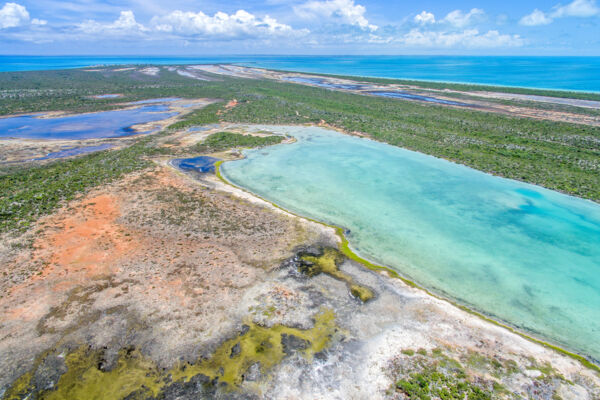
Lake Catherine in the center of West Caicos is the island’s greatest defining feature. This saline 500-acre (202-hectare) lake is a protected area, the Lake Catherine Nature Reserve, and home to large numbers of bird and aquatic wildlife. Due to subterranean links with the ocean, Lake Catherine is tidal. These caves have been partially explored by divers from the Caicos Cave Project, but a clear connection tunnel to the ocean is still undiscovered due to difficult currents and the fragile rock composition of the caverns.
Lake Catherine supports some of the greatest populations of West Indian flamingos (Phoenicopterus ruber) in the Turks and Caicos. The eastern half of the interior saline ponds tends to be the favored location of these large wading birds.
A small railway causeway cuts across the ponds from Yankee Town to the central east coast of West Caicos. This small-scale rail system utilized carts pulled by donkeys, and transported sisal stalks for processing and export.
A Brief History of West Caicos
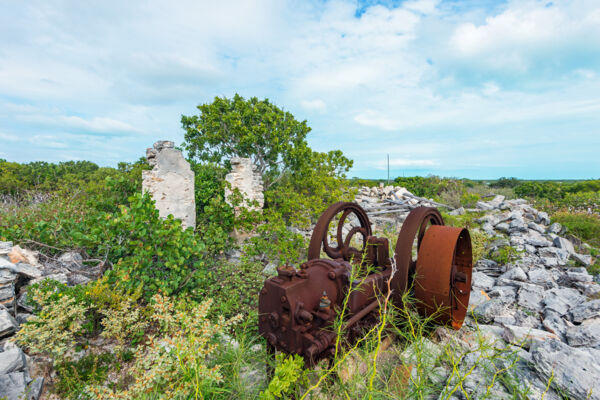
Although more or less uninhabited for the last 100 years, West Caicos has had quite a few interesting bits of history, with recorded events dating back to the 1500s.
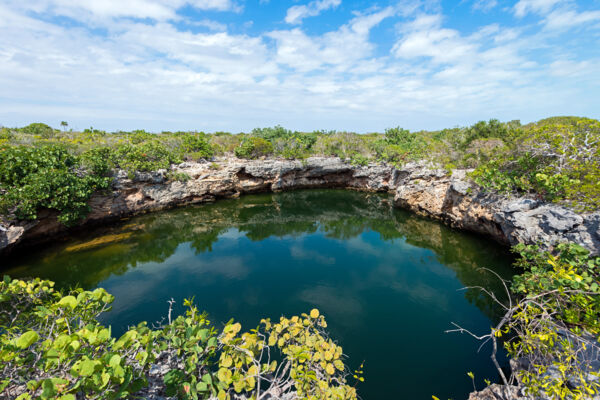
It’s known that the Spaniards in Hispaniola in the mid-1500s knew of the natural salt in West Caicos and the rest of the country and would rake salt during the dry season. The word got out and ships would occasionally stop when in the area.
One such example is the visit of John White of Roanoke Island fame. On his second voyage to the New World visited West Caicos in 1587 hoping to collect naturally evaporated sea salt. However, due to rainfall, none was found. Instead, “swanees” (probably flamingos) were hunted and gathered for food. Some of his famous illustrations of fauna, including of flamingos, iguanas, blue land crabs, and Caribbean scorpions, may have been done on West Caicos, as that array of wildlife is exactly what he is likely to have seen and been able to approach in the Turks and Caicos!
Pirates
Pirates and privateers have also had a lingering history with West Caicos. Because of the Atlantic North Equatorial Current, ships in the 1500s and 1600s when sailing to the newly discovered lands of the Americas and the Caribbean would often first approach land in the region north of Hispaniola before continuing on to their final destination. The Turks and Caicos is located in this area, so pirates based in the islands had many opportunities to prey on ships.
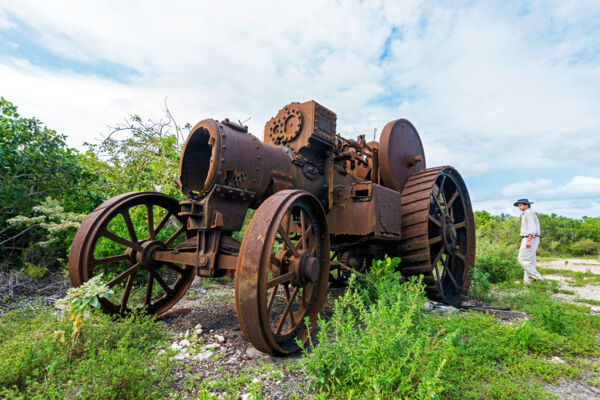
Modern popular culture presents an idea of pirates of the period sailing in large ships, but the reality is the opposite. Nearly all pirate vessels operating in the Atlantic were heavily armed smaller ships, able to hide on the coast and maneuver better than the larger merchant ships of the day. These crafts were effective at hiding in the natural coves, shallows, and inlets found across the Caicos islands, where navigation with a larger vessel would be difficult.
Although West Caicos was used as a temporary stopping place by many renegades, records are only definite on the French Pirate Dulaien as having an established base on West Caicos.
Salt
Like many of the larger islands in the Turks and Caicos, West Caicos has several natural shallow saltwater ponds. In the mid-1800s, salt production was the major industry in the Turks and Caicos and interest was shown in developing the salt salinas of West Caicos.
Because of the extent of the natural ponds, the total potential output could have been greater than the other salt-producing islands in the country. However, as time went on demand generally switched to less expensive mined salt, and the industry collapsed in the Turks and Caicos before anything was carried out.
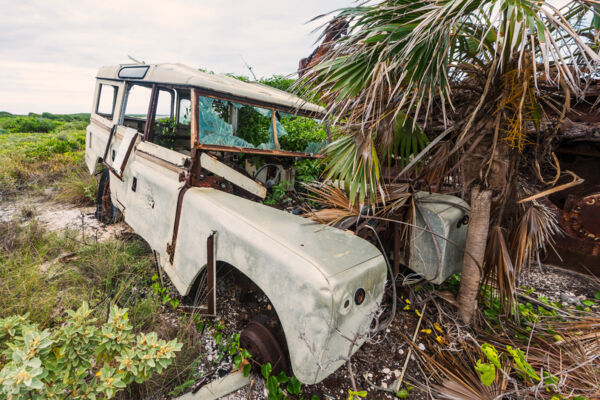
Yankee Town and Sisal
The only main agricultural attempt on West Caicos was Sisal Farming in the late 1800s and early 1900s. The sisal (in the past also called Pita) is an agave type plant that produces very strong fibers that are used to make rope and twine.
However brief, this era was the most successful period of time on West Caicos and at the height of production, the island had about 1500 acres (600 hectares) planted. Several different firms were raising the plant, but the largest was the West Caicos Fiber Company.
A small-scale railroad, with a network of causeways and cuts, facilitated the transport of sisal stalks to Yankee Town. The railroad tracks on West Caicos were signs of the changing times and mass production, with stamped steel sleepers and bolted rails. The rail systems on East Caicos were only a little older, yet utilized locally harvested wood sleepers and forged rail spikes.
Once on the west coast near Yankee Town, the sisal stalks would be processed with the “Fiber Decortigating Machine” to remove water and non-fiber matter, dried, and then compressed into bales. A massive screw press was used to make the bales, the remains of which can still be seen on the coast of West Caicos.
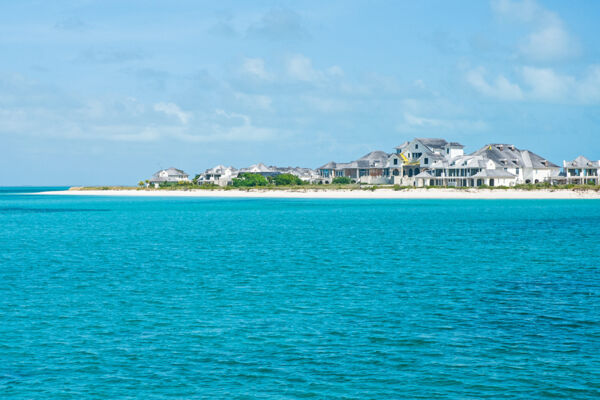
Sisal was the last major crop grown in the Turks and Caicos. Cultivation of this agave took place across the Turks and Caicos in the early 1900s, yet East Caicos and West Caicos were the only sites where significant investment into the industry took place.
Due to increasingly widespread use of synthetic fibers and ropes, all organized production in the country ceased by 1919 and West Caicos was gradually abandoned. The remains of the small settlement Yankee Town and a 12-ton steam tractor are the majority of what can be seen today of the sisal period of history.
Modern Era
In 1972, an entirely different project was started. This attempt was an oil transshipment station and possible oil refinery. Because of the introduction of stricter environmental regulations in the United States, many oil companies were looking at refining outside of the United States. West Caicos is centrally located between the US and South America, and in places has deep water close to the coast, so the island was a prime candidate for such a project. Fortunately for the country, this transshipment station was never built. An unpaved airstrip was also constructed at this time, but only saw limited use of probably dubious legality before the vegetation reclaimed it.
Ritz-Carlton Molasses Reef Project
More recently a resort and luxury residence development, the Ritz-Carlton Molasses Reef project, was started in 2006 and was intended to have a marina, private villas, and resort. However, due to the collapse of the main financial backer, Lehman Brothers, the construction was put on indefinite hold. Unfinished buildings from this project can be seen off the north end of West Caicos.
Recent Development
European developers purchased the uncompleted Molasses Reef hotel project in 2012, and a development agreement was reached with the TCI Government.
Attempts have been made to restart the luxury resort and condominium project, yet progress has been slow. Much of the unfinished infrastructure would have to be demolished and rebuilt, yet the site may remain as a Ritz-Carlton Reserve brand.
Getting to West Caicos
At this time, no regular boat cruises or ferry services are offered to West Caicos. Dive boats often visit the excellent reefs around the island, but only private vessels tend to land, usually on day trips. To visit West Caicos, it will probably be necessary to arrange a custom charter through one of the local dive or water sports operators. Such a trip will probably be expensive compared to the other boat excursions available.
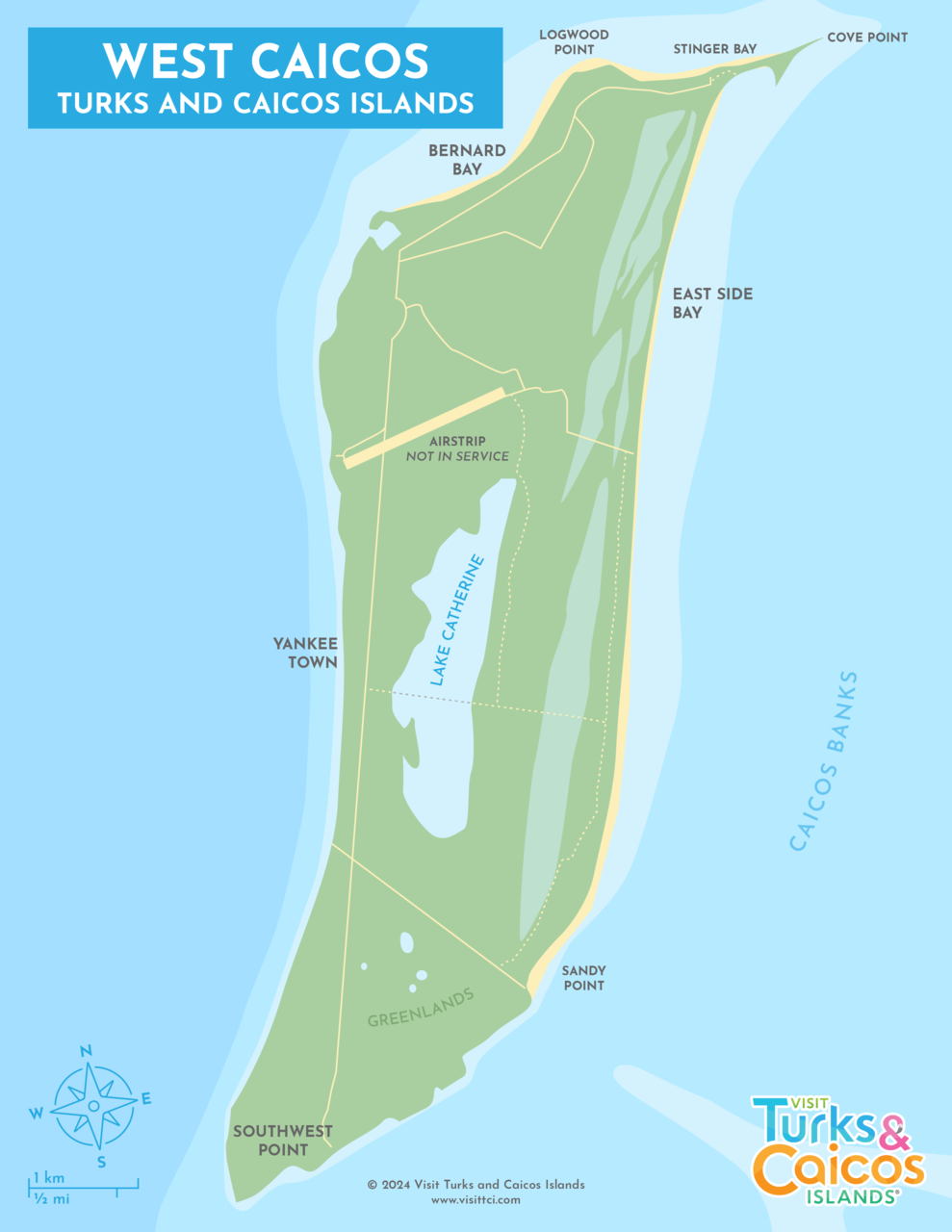
Tours and Charters
